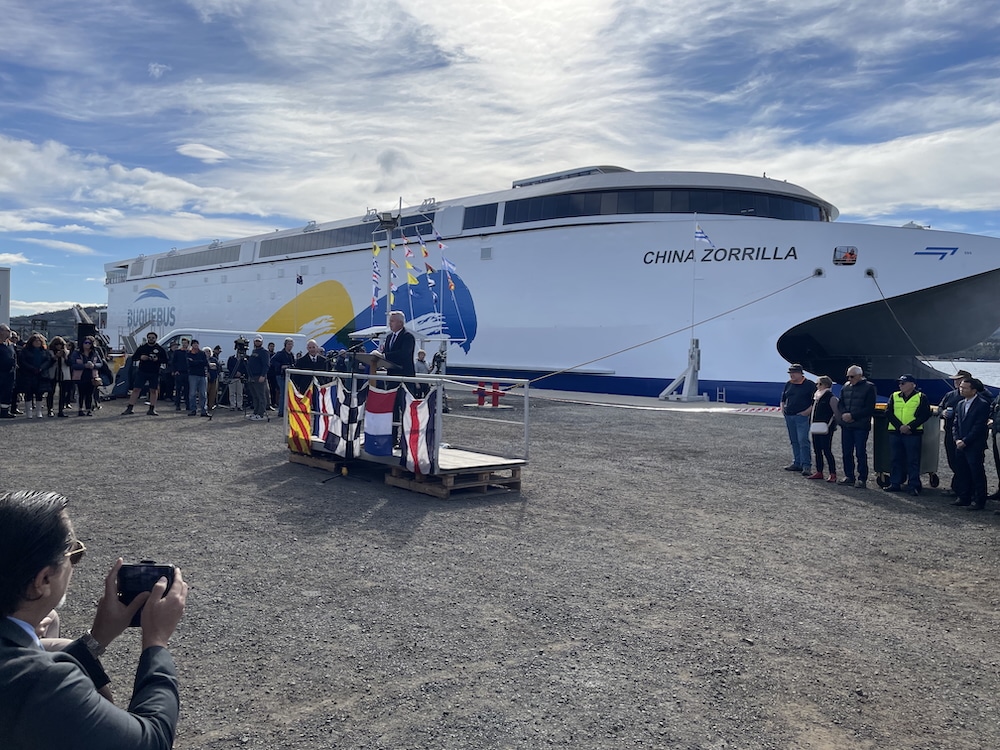This post was originally published on Eco Watch
A 426-foot-long electric ship — the largest of its kind in the world — launched from Tasmania this week, marking a milestone in the clean energy transition for maritime shipping.
The Hull 096 boat, called China Zorrilla after the famous actress from Uruguay, was made by Incat Tasmania for operation by Buquebus. According to Incat, the battery-powered ship will travel between Buenos Aires, Argentina and Colonia, Uruguay, with a capacity to carry up to 2,100 passengers as well as 225 vehicles.
According to Buquebus President Juan Carlos López Mena, Hull 096 was originally supposed to run on liquified natural gas (LNG) for fuel, but a conversation with Incat Chairman Robert Clifford lead to a shift to create the world’s largest electric ship. The resulting ship includes more than 250 metric tons of batteries along with 40 megawatt-hours of capacity in the Energy Storage System (ESS), Incat reported. Hull 096’s ESS is four times larger than any similar maritime system in the world.
“We’re not just building a ship — we’re building the future,” Incat CEO Stephen Casey said in a press release. “Hull 096 proves that large-scale, low-emission transport solutions are not only possible, they are ready now. This is a proud day for Tasmania and for Australian manufacturing.”
Following the launch, Incat and its partners will finish completing the interior of Hull 096, and finalizations will occur as the team prepares the boats for trials at sea later in 2025.
The International Energy Agency (IEA) determined that as of 2022, shipping accounted for about 2% of all energy-related carbon emissions. With projected increases in shipping demand globally, transitioning to cleaner fuel sources for ships will be essential to minimizing emissions.
Last month, countries in the UN International Maritime Organization (IMO) Marine Environment Protection Committee voted to reduce shipping emissions and aim for net-zero emissions in the shipping industry by 2050. The framework for the committee’s target will include setting a fuel standard to lower emissions related to marine fuels over time and set a fee that ships pay if they exceed emissions limits.
The China Zorrilla was launched at Incat’s shipyard in Hobart, Tasmania. Incat
According to the Lawrence Berkeley National Laboratory, electric ships could offer significant greenhouse gas emissions reductions compared to conventional ships that run on fossil fuels. In a 2023 report, the lab showed that electrifying U.S. ships with 1,000 or less gross tonnage would reduce emissions 34% to 42% by 2035 (compared to 2022 levels) and 75% by 2050 while fully meeting trip demand.
The launch of the largest electric ship could play a part in reducing emissions globally if more fleet owners transition to electric-powered ships in the future.
Roger Holm, president of Wärtsilä Marine and executive vice president at Wärtsilä Corporation that collaborated on Hull 096, said, “Ferries play a vital role in meeting the growing demand for environmentally sustainable transport options, with ship electrification a key solution for enabling the sector to transition towards net-zero emissions.”
The post World’s Largest Electric Ship Sets Sail From Tasmania appeared first on EcoWatch.





0 Comments